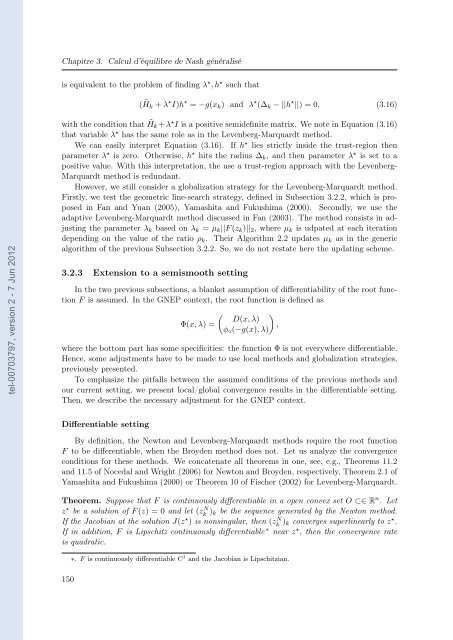Etude des marchés d'assurance non-vie à l'aide d'équilibres de ...
Etude des marchés d'assurance non-vie à l'aide d'équilibres de ...
Etude des marchés d'assurance non-vie à l'aide d'équilibres de ...
You also want an ePaper? Increase the reach of your titles
YUMPU automatically turns print PDFs into web optimized ePapers that Google loves.
tel-00703797, version 2 - 7 Jun 2012<br />
Chapitre 3. Calcul d’équilibre <strong>de</strong> Nash généralisé<br />
is equivalent to the problem of finding λ ⋆ , h ⋆ such that<br />
( ˜ Hk + λ ⋆ I)h ⋆ = −g(xk) and λ ⋆ (∆k − ||h ⋆ ||) = 0, (3.16)<br />
with the condition that ˜ Hk +λ ⋆ I is a positive semi<strong>de</strong>finite matrix. We note in Equation (3.16)<br />
that variable λ ⋆ has the same role as in the Levenberg-Marquardt method.<br />
We can easily interpret Equation (3.16). If h ⋆ lies strictly insi<strong>de</strong> the trust-region then<br />
parameter λ ⋆ is zero. Otherwise, h ⋆ hits the radius ∆k, and then parameter λ ⋆ is set to a<br />
positive value. With this interpretation, the use a trust-region approach with the Levenberg-<br />
Marquardt method is redundant.<br />
However, we still consi<strong>de</strong>r a globalization strategy for the Levenberg-Marquardt method.<br />
Firstly, we test the geometric line-search strategy, <strong>de</strong>fined in Subsection 3.2.2, which is proposed<br />
in Fan and Yuan (2005), Yamashita and Fukushima (2000). Secondly, we use the<br />
adaptive Levenberg-Marquardt method discussed in Fan (2003). The method consists in adjusting<br />
the parameter λk based on λk = µk||F (zk)||2, where µk is udpated at each iteration<br />
<strong>de</strong>pending on the value of the ratio ρk. Their Algorithm 2.2 updates µk as in the generic<br />
algorithm of the previous Subsection 3.2.2. So, we do not restate here the updating scheme.<br />
3.2.3 Extension to a semismooth setting<br />
In the two previous subsections, a blanket assumption of differentiability of the root function<br />
F is assumed. In the GNEP context, the root function is <strong>de</strong>fined as<br />
Φ(x, λ) =<br />
<br />
D(x, λ)<br />
,<br />
φ◦(−g(x), λ)<br />
where the bottom part has some specificities: the function Φ is not everywhere differentiable.<br />
Hence, some adjustments have to be ma<strong>de</strong> to use local methods and globalization strategies,<br />
previously presented.<br />
To emphasize the pitfalls between the assumed conditions of the previous methods and<br />
our current setting, we present local/global convergence results in the differentiable setting.<br />
Then, we <strong><strong>de</strong>s</strong>cribe the necessary adjustment for the GNEP context.<br />
Differentiable setting<br />
By <strong>de</strong>finition, the Newton and Levenberg-Marquardt methods require the root function<br />
F to be differentiable, when the Broy<strong>de</strong>n method does not. Let us analyze the convergence<br />
conditions for these methods. We concatenate all theorems in one, see, e.g., Theorems 11.2<br />
and 11.5 of Nocedal and Wright (2006) for Newton and Broy<strong>de</strong>n, respectively, Theorem 2.1 of<br />
Yamashita and Fukushima (2000) or Theorem 10 of Fischer (2002) for Levenberg-Marquardt.<br />
Theorem. Suppose that F is continuously differentiable in a open convex set O ⊂∈ R n . Let<br />
z ⋆ be a solution of F (z) = 0 and let (z N k )k be the sequence generated by the Newton method.<br />
If the Jacobian at the solution J(z ⋆ ) is <strong>non</strong>singular, then (z N k )k converges superlinearly to z ⋆ .<br />
If in addition, F is Lipschitz continuously differentiable ∗ near z ⋆ , then the convergence rate<br />
is quadratic.<br />
150<br />
∗. F is continuously differentiable C 1 and the Jacobian is Lipschitzian.
















